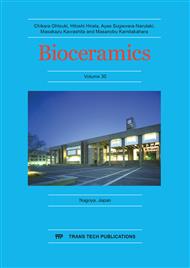p.201
p.207
p.212
p.218
p.227
p.233
p.238
p.244
p.250
Sintering Temperature Effect on Hardness of Self-Synthetisized Porcelain Made from Natural Sumatran Sand without Kaolin
Abstract:
Dental porcelain is one of the indirect restoration material with excellent aesthetic properties,on the other hand porcelain hardness frequently causing excessive wear of antagonist teeth. This study aiming to evaluate the effect of sintering temperature on the self-synthesized porcelain hardness. In this experiment, 25 porcelain samples were synthesized using Sumatran sand from Pangaribuan and Belitung regions, with the composition of 65 wt% Pangaribuan feldspar, 25 wt% Belitung silica and 10 wt% potassium salt. The samples were sintered in five different temperatures, which were 1110°C (A), 1120°C (B), 1130°C (C), 1140°C (D), and 1150°C (E). These samples were then invested on 5cm diameter resin each. The hardness was tested using Zwick Roell ZHμ Micro Vickers with 900 gram load for 15 seconds in 5 different indented areas for each sample. The result shows average hardness of 435.8 VHN (A), 461.0 VHN (B), 472.0 VHN (C), 487.6 VHN (D), and 528.7 VHN (E), which were increasing as the sintering temperature increased. Statistic result shows that sintering temperature significantly affected the hardness value of the porcelain (p value < 0.05). In conclusion sintering temperature affects the hardness of self-synthesized porcelain made from Sumatran natural sand without kaolin, although the average hardness of self-synthesized porcelain is still higher than average hardness of teeth enamel.
Info:
Periodical:
Pages:
227-232
Citation:
Online since:
October 2018
Keywords:
Price:
Сopyright:
© 2018 Trans Tech Publications Ltd. All Rights Reserved
Share:
Citation:


